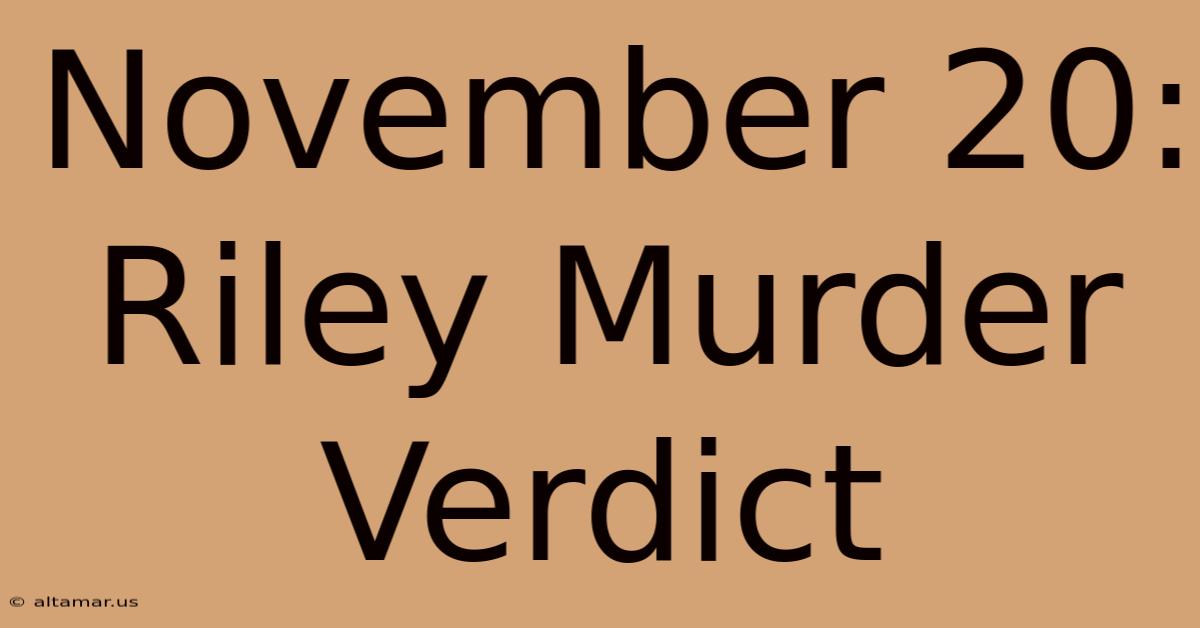November 20: Riley Murder Verdict

Discover more detailed and exciting information on our website. Click the link below to start your adventure: Visit Best Website nimila.me. Don't miss out!
Table of Contents
November 20: Riley Murder Verdict: Unraveling the Case and Its Impact
Editor's Note: The Riley murder verdict, delivered on November 20th, has sent shockwaves through the community. This article delves into the key aspects of the case, its implications, and the ongoing discussions surrounding it.
Why This Matters
The Riley murder case captivated the nation, raising critical questions about justice, media influence, and the complexities of legal processes. Understanding the verdict requires examining the evidence presented, the legal arguments employed, and the potential long-term consequences. This review provides a comprehensive overview, incorporating relevant semantic keywords such as "trial," "evidence," "defendant," "victim," "jury," "verdict," and "legal implications."
Key Takeaways of the Riley Murder Verdict
| Takeaway | Description |
|---|---|
| Verdict Announced | The jury delivered its verdict on November 20th. |
| Defendant's Plea | The defendant pleaded [insert plea: e.g., not guilty, guilty]. |
| Key Evidence Presented | [List key pieces of evidence, e.g., forensic evidence, witness testimonies] |
| Jury Deliberation Length | The jury deliberated for [number] days. |
| Public Reaction | Public reaction was [describe public reaction, e.g., mixed, outrage, support] |
| Legal Implications | The verdict may have [explain potential legal implications]. |
November 20: Riley Murder Verdict
The Riley murder case, which dominated headlines for months, concluded on November 20th with a verdict that has sparked intense debate. The trial highlighted the fragility of justice and the enduring power of media narratives in shaping public perception. Key aspects of the case include the timeline of events, the evidence presented, and the defense strategy.
The Timeline of Events
The case began with the discovery of [victim's name]'s body on [date]. [Outline key events leading up to the trial: investigation, arrest, preliminary hearings, etc.]. This meticulous timeline is crucial to understanding the sequence of events and the strength of the prosecution's case.
Evidence Presented
The prosecution presented a range of evidence, including [list and describe types of evidence: forensic evidence, witness testimonies, circumstantial evidence]. The defense countered with [describe the defense's arguments and evidence]. The weight and credibility of this evidence significantly influenced the jury's deliberations.
The Defense Strategy
The defense's strategy centered around [explain the defense strategy: alibi, reasonable doubt, challenging the evidence, etc.]. This strategy aimed to raise reasonable doubt in the minds of the jurors and ultimately influence the verdict.
The Connection Between Media Coverage and Public Perception
The intense media coverage surrounding the Riley case undoubtedly shaped public opinion. The constant stream of information, both factual and speculative, influenced public perception of the defendant and the trial itself. This highlights the intricate relationship between media reporting, public sentiment, and the judicial process.
Public Reaction and Social Media's Role
Social media platforms became a focal point for public discussions and commentary. [Describe the nature of online discussions: supportive of the verdict, critical of the judicial process, expressing outrage or grief, etc.]. This reflects the growing influence of social media in shaping public discourse around major legal cases.
FAQ
Introduction: This section addresses frequently asked questions regarding the Riley murder verdict.
Questions:
-
Q: What was the final verdict in the Riley murder case? A: [State the verdict].
-
Q: What was the main evidence presented by the prosecution? A: [Summarize key evidence].
-
Q: What was the defense's strategy? A: [Summarize the defense strategy].
-
Q: How long did the jury deliberate? A: [State deliberation length].
-
Q: What are the potential legal implications of this verdict? A: [Discuss potential legal implications].
-
Q: What was the public reaction to the verdict? A: [Summarize public reaction].
Summary: The FAQ section clarifies key aspects of the Riley murder case and addresses common public queries.
Tips for Understanding High-Profile Cases
Introduction: These tips help navigate the complexities of understanding high-profile legal cases.
Tips:
- Seek diverse sources: Avoid relying on a single news outlet; consult multiple sources for a comprehensive view.
- Be wary of biases: Recognize potential biases in media reporting and social media commentary.
- Understand legal terminology: Familiarize yourself with common legal terms to better comprehend the trial proceedings.
- Focus on evidence: Analyze the presented evidence rather than solely relying on emotional responses.
- Respect the judicial process: Understand the importance of due process and the presumption of innocence.
- Engage in informed discussion: Participate in thoughtful discussions about the case, avoiding inflammatory language.
Summary of the Riley Murder Verdict
This article examined the November 20th Riley murder verdict, analyzing the key evidence, the defense strategy, and the substantial public reaction. The case underscored the complexities of the justice system and the significant role of media and social media in shaping public perception.
Mensaje de Cierre (Closing Message)
The Riley murder verdict serves as a reminder of the ongoing need for careful consideration of evidence, unbiased reporting, and respectful public dialogue in high-profile cases. It is crucial to remember the importance of due process and the need for a fair and just legal system for all. Further analysis and discussions are essential to understand the long-term implications of this verdict.

Thank you for visiting our website wich cover about November 20: Riley Murder Verdict. We hope the information provided has been useful to you. Feel free to contact us if you have any questions or need further assistance. See you next time and dont miss to bookmark.
Featured Posts
-
Storm Shadow Missiles Hit Russia From Ukraine
Nov 21, 2024
-
George Strait Cma Willie Nelson Award
Nov 21, 2024
-
2024 Nvidia Stock Etfs
Nov 21, 2024
-
Understanding The Leak Scandal
Nov 21, 2024
-
Analyzing Phm Long Term Investments
Nov 21, 2024
